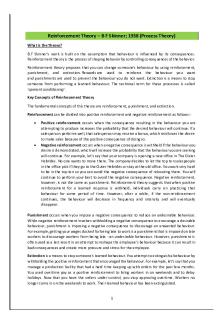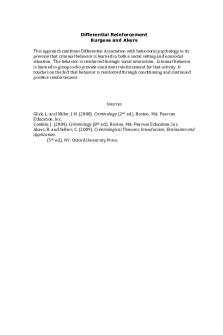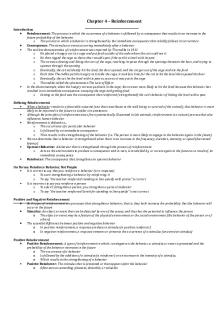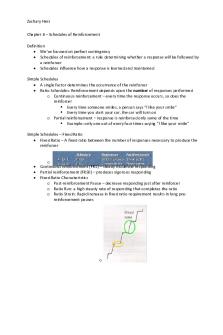Chapter 3 Escape (Negative Reinforcement) PDF

| Title | Chapter 3 Escape (Negative Reinforcement) |
|---|---|
| Author | Sunho Kim |
| Course | Basics of Behavior Analysis |
| Institution | National University (US) |
| Pages | 3 |
| File Size | 143.7 KB |
| File Type | |
| Total Downloads | 20 |
| Total Views | 201 |
Summary
Principles of Behavior by Malott (7th) Ch:3...
Description
Chapter 3: Escape (Negative Reinforcement) Fundamentals:
Negative Reinforcement - r emoval/reduction of an aversive stimulus, contingent on a response, reinforces that response and as a result, the frequency of that response class increases Aversive Stimulus - stimulus that increases future frequency of a response; its removal follows -
Dislike is not a reliable criterion for an aversive stimulus: ex. Hearing a scary story can be aversive but you may still like it
Criterion for Aversive Stimulus - a condition/stimulus is aversive if its termination reinforces an escape response Escape Principle - a response becomes more likely if it has removed or reduced an aversive stimulus in the past Escape Contingency - the response-contingent removal of an aversive stimulus, resulting in an increased frequency of that response Reinforcement by Presentation of Reinforcer vs. Reinforcement by Removal of Aversive Stimulus
-
Both produce the same results: increased response frequency
-
Different because one presents a reinforcer, the other removes aversive stimulus
The tree diagram is saying we use reinforcement contingency in what 2 ways: 1. Specific Way - referring to the contingency involving the presentation of the reinforcer 2. General Way - referring to any contingency that reinforces behavior, and includes both reinforcement and escape
Differential Reinforcement of Alternative Behavior (DRA) - replacement of an inappropriate response with a specific appropriate response that produces the same reinforcing outcome -
2 things happen when you differentially reinforce the appropriate alternative response: 1. You will decrease frequency of disrupting 2. You will increase frequency of asking, “Am I doing good work”
Functional Assessment - assessment of the contingencies responsible for behavioral problems 3 Functional-Assessment Strategies - also known as functional analysis 1. Interview
2. Observe 3. Intervene
Sick Social Cycle (Victim’s Escape Model) - in escaping the perpetrator’s aversive behavior, the victim unintentionally reinforces that aversive behavior Contingencies can control our behavior, even when we are unaware of those contingencies, the behavior, or that any controlling is going on (at least when outcome follows behavior within a fraction of a second) - ie Group 1 in thumb twitch experiment Parsimony - the use of no unnecessary concepts, principles, or assumptions BF Skinner is the most famous psychologist in the world Psychologist vs. Psychiatrist 1. Psychiatry - speciality in medicine, just like surgery a. Psychiatrist - must have an MD degree 2. Psychology - branch of arts & sciences a. Psychologists - must have PhD, MA, or BA degree -
Both deal with understanding & improvement of behavior/mind, depending on whether you are a behaviorist or mentalist
Psychoanalysis vs Behavior Analysis 1. Behavior Analysis - behavioristic approach to study and improve behavior a. Past consequences cause current behavior 2. Psychoanalysis - mentalistic approach to study and improve behavior and mind a. Past experiences cause current behavior by channeling unconscious mental forces -
Both argue that experiences causes behavior
-
Differ in that behavior analysis points to past consequences as crucial cause while psychoanalysis points to unconscious mental forces (influenced by experience) as crucial cause
Toothpaste Theory of Abnormal Behavior - abnormal behavior flows out of sick people -
Like toothpaste squeezed from a tube, the abnormal behavior results from inner pressure
Remember! We call: -
Positive reinforcers, just reinforcers
-
Positive Reinforcement, reinforcement by presentation of a reinforcer
-
Negative reinforcer, an aversive condition
-
Negative reinforcement, reinforcement by removal of aversive condition...
Similar Free PDFs

assignment 3- negative message
- 2 Pages

Escape Rooms
- 24 Pages

Reinforcement-Theory
- 2 Pages

Differential reinforcement
- 4 Pages

Differential Reinforcement
- 1 Pages
Popular Institutions
- Tinajero National High School - Annex
- Politeknik Caltex Riau
- Yokohama City University
- SGT University
- University of Al-Qadisiyah
- Divine Word College of Vigan
- Techniek College Rotterdam
- Universidade de Santiago
- Universiti Teknologi MARA Cawangan Johor Kampus Pasir Gudang
- Poltekkes Kemenkes Yogyakarta
- Baguio City National High School
- Colegio san marcos
- preparatoria uno
- Centro de Bachillerato Tecnológico Industrial y de Servicios No. 107
- Dalian Maritime University
- Quang Trung Secondary School
- Colegio Tecnológico en Informática
- Corporación Regional de Educación Superior
- Grupo CEDVA
- Dar Al Uloom University
- Centro de Estudios Preuniversitarios de la Universidad Nacional de Ingeniería
- 上智大学
- Aakash International School, Nuna Majara
- San Felipe Neri Catholic School
- Kang Chiao International School - New Taipei City
- Misamis Occidental National High School
- Institución Educativa Escuela Normal Juan Ladrilleros
- Kolehiyo ng Pantukan
- Batanes State College
- Instituto Continental
- Sekolah Menengah Kejuruan Kesehatan Kaltara (Tarakan)
- Colegio de La Inmaculada Concepcion - Cebu










